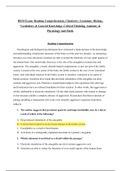Exam (elaborations)
TEST BANK FOR RN ATI FUNDAMENTALS (ALL CHAPTERS 1- 58 WITH QUESTIONS AND ANSWERS)/FUNDAMENTALS OF NURSING 10TH EDITION (10.0) ATI, CONTENT MASTERY SERIES REVIEW MODULE
- Course
- Institution
TEST BANK FOR RN ATI FUNDAMENTALS (ALL CHAPTERS 1- 58 WITH QUESTIONS AND ANSWERS)/FUNDAMENTALS OF NURSING 10TH EDITION (10.0) ATI, CONTENT MASTERY SERIES REVIEW MODULE
[Show more]












